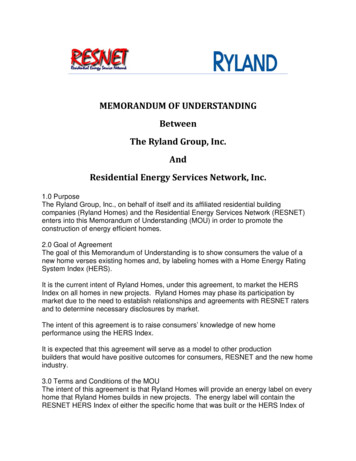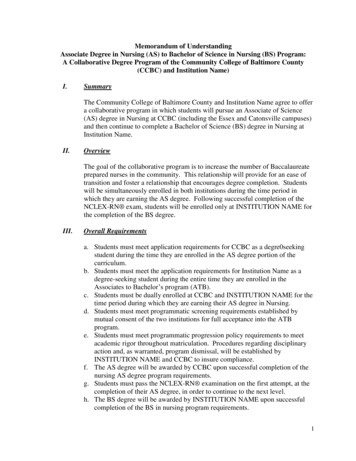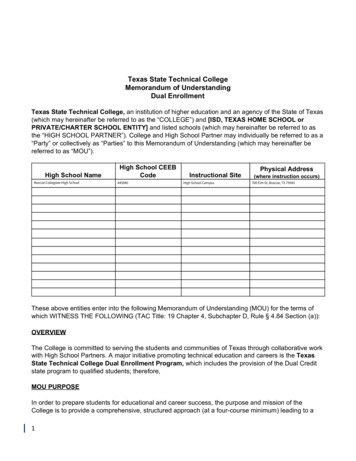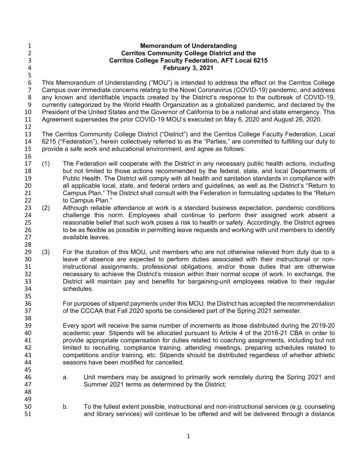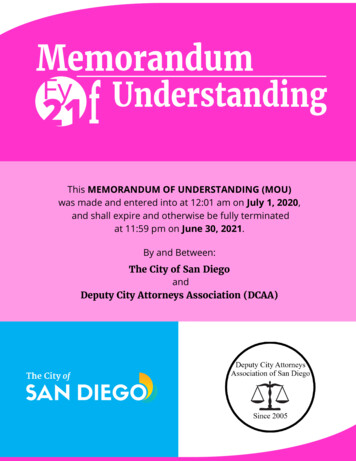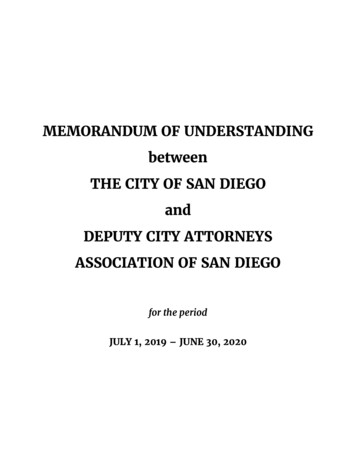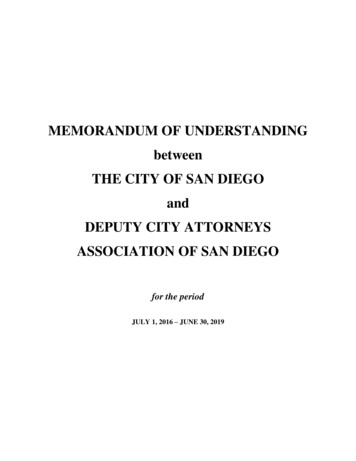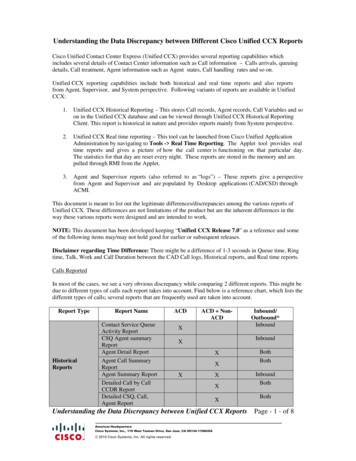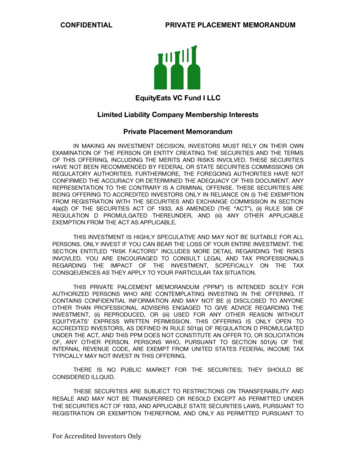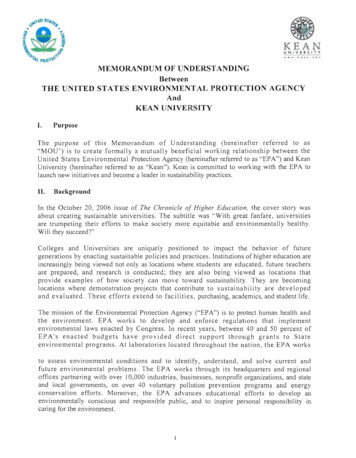
Transcription
I)KEANUNI VE RS ITYMEMORANDUM OF UNDERSTANDINGBetweenTHE UNITED STATES ENVIRONMENTAL PROTECTION AGENCYAndKEAN UNIVERSITYI.PurposeThe purpose of this Memorandum of Understanding (hereinafter referred to as"M O U') is to create formally a mutually beneficial working relationship between theUnited States Environmental Protection Agency (hereinafter referred to as "EPA") and KeanUniversity (hereinafter referred to as "Kean"). Kean is committed to working with the EPA tolaunch new initiatives and become a leader in sustainability practices.II.BackgroundIn the October 20 , 2006 issue of The Chronicle of Higher Education, the cover story wasabout creating sustainable universities . The subtitle was "With great fanfare , universitiesare trumpeting their efforts to make society more equitable and environmentally healthy.Will they succeed?"Colleges and Universities are uniquely positioned to impact the behavior of futuregenerations by enacting sustainable policies and practices. Institutions of higher education areincreasingly being viewed not only as locations where students are educated, future teachersare prepared, and research is conducted; they are also being viewed as locations thatprovide examples of how society can move toward sustainability . They are becominglocations where demonstration projects that contribute to sustainability are developedand evaluated. These efforts extend to facilities, purchasing, academics, and student life.The mission of the Environmental Protection Agency ("EPA") is to protect human health andthe environment. EPA works to develop and enforce regulations that implementenvironmental laws enacted by Congress. In recent years, between 40 and 50 percent ofEPA's enacted budgets have provided direct support through grants to Stateenvironmental programs . At laboratories located throughout the nation, the EPA worksto assess environmental conditions and to identify, understand, and solve current andfuture environmental problems . The EPA works through its headquarters and regionaloffices partnering with over lO,OOO industries, businesses, nonprofit organizations, and stateand local governments, on over 40 voluntary pollution prevention programs and energyconservation efforts. Moreover, the EPA advances educational efforts to develop anenvironmentally conscious and responsible public, and to inspire personal responsibility incaring for the environment.
Kean is committed to serving the educational needs of New Jersey with programscharacterized by academic rigor and currency in the development of knowledge and itsapplications. Kean serves as a center for the creation of new knowledge and for thedevelopment of innovative applications of existing knowledge and as a center forpedagogical and artistic excellence and creativity. Kean will playa role beyond thecampus community, partnering and collaborating at the local, state, national andinternational levels to make positive contributions to addressing issues of importance tosociety, to enable students to experience their ability to use knowledge in constructiveways in the world , and to share the rich array of intellectual and cultural resources of theUniversity with the people of New Jersey and beyond.The EPA and Kean will , through this MOU , continuously collaborate to developand promote environmentally sustainable practices . This MOU will include 34on-campus buildings as well as 185 acres of campus grounds. K ean shall also takesteps to reduce the solid waste stream . Further, it will enhance current source separation andmaterial recycling for which a market exists, including but not limited to: paper, cardboard, newsprint, metal, glass, plastic and electronics.III.MOU CommitmentsThe Parties recognize the importance of collaboration to serve the needs of societythrough proper design , construction , and management of the nation's post-secondaryinstitutions. Consequently, the Parties are hereby establishing a working relationship ,and undertaking certain commitments with respect to campus infrastructure andoperations as they relate to environmental issues , including , but not limited to thefollowing specific undertakings r e lated to university facilities and academicprogramming at Kean.A. Un iversity Facilities and Green Operations1. Environmental Management Systems ("EMS',)Kean will work with the EPA to develop a comprehensive EnvironmentalManagement System for the University. Kean ' s EMS will be a set of processes andpractices that enable the University to reduce its environmental impacts and increaseits operating efficiency.2. Municipal Solid Waste ("MSW'') Recycling and Re-Use Waste Wise ProgramKean will join EPA's Waste Wise program , which provides technicalassistance to members for auditing MSW generation rates and developingMS W reduction and recycling plans. Members also set their own recycling goals.Listed below are some of the ongoing MSW recycling activities being conductedat Kean.a. Organics/Food Waste CompostingFood scraps will be collected from all dining facilities on campus . Thescraps will be collected daily in either 5 or 10 gallon buckets. The bucketswill be collected and weighed. The scraps will then be processed in a state of-the-art aerobic in-vessel digester that was custom designed for Keanbased on a food waste audit that was conducted during the summer of2
2009. Kean will endeavor to eliminate food scraps from its waste stream.T hese plans also include eliminating the serviceware currently being usedin favor of compostable serviceware, which will further reduce the amountof waste generated on campus and the energy required to wash servicewarethat is not disposable.The finished compost will be used in landscaping projects on campus, resultingin a decrease in the amount of synthetic fertilizer used and a decrease in theamount of topsoil and decorative mulch (both of which have environmentalimpacts) that must be purchased.b. Mixed Fiber (Paper) and Bottles/Cans RecyclingKean has an existing contract that provides for the recycling ofpaper, cardboard, and co-mingled cans and bottles. This activity continuesto be successful in that the volume and percentage of paper, bottles/cansbeing recycled are consistently increasing each year. Kean utilizes a paperand cardboard compactor to maximize capacity and minimize the number ofpickups, thereby reducing fossil fuel consumption.All Kean facilities must be adaptable to its recycl ing program andprovide collection containers that are placed adjacent to trash receptacles in anaesthetically pleasing display. The units are easy to access by housekeepingpersonnel when discarding items. Any hazardous wastes managed within thefacility are appropriately contained and provisions are made for their properdisposal.c. Recyclemania CompetitionKean will participate in the RecycleMania event sponsored by EPA. Thisyear (2010) is the first time Kean is participating in the program. Keanintends to participate annually in an effort to educate the campus communityabout solid waste management and to reduce the solid waste produced oncampus .d. Environmentally Preferable ("Green ") ProductsKean is committed to green cleaning in all of its facilities . In 2006 formerGovernor Codey signed Executive Order #76 , which mandates all Statefacilities to use less hazardous cleaning products. Currently, 50 % of allcleaning products used on campus are Green Seal certified. Kean uses GreenSeal Certified products wherever a Green Seal product is available. Further,Kean is currently preparing a public bid specification that will require allnew environmentally friendly cleaning supplies, including such items asmop heads, floor stripper/wax.Currently, paper hand towels and toilet paper are made of recycled materials andKean will investigate the possibility of using office paper made from recycledcontent.Kean is also investigating a 'chemical free ' cleaning process for our cooling3
towers. This method will potentially replace current chemical methodsbeing used for the destruction of bacteria.e. Kean Reforestation Program.Consistent with New Jersey's No Net Loss Reforestation Act, NJSA 13: lL 14.1 et. seq, by the end of 2010 Kean will have planted approximately 600trees on campus. This has been an ongoing since 2008.f.Electronics Waste (E-Waste) Recycling.Computer components / CRTs contain hazardous substances, which canharm the environment if they are simply put out with the trash. Theseitems and similar ones contain cadmium, lead, and mercury, which canmake their way into landfills or incinerators, and require substantialcost and effort to assure that these hazardous substances are not releasedinto the air or water.Kean's Office of Computer and Information Services has contracted with acomputer and electronics recycling firm to properly handle the retirement of allE-Waste that is not leased or returned to the supplier at the end of its lifecycle. Currently, our E-Waste is taken to a non-profit organization thatrefurbishes the computer equipment and uses it in job retraining efforts. All E Waste not re-used is recycled appropriately.B. Energy Management, Green Power, Energy Conservation and Reduction of theKean Carbon Footprint1. Energy Usage and Carbon Footprint ReductionFuture energy assessment and reduction plans include: Joining the Energy Star Program as a partner, including benchmarkingenergy consumption for new and existing buildings, reducing energy usage by10% and educating students and employees on energy conservationtechniques;Sub-metering buildings to track electrical energy consumption. Currently fourbuildings are sub-metered and the information is tracked with a softwareprogram that is viewable in real time. Sub-metering will allow us to identifytrends and possible opportunities for energy savings;Conducting and providing an audit of the critical energy and utilitiesinfrastructure to ensure that business continuity best practices aredeveloped to assist in the event of an emergency or threat;Researching the feasibility of adding renewable energy sources such aswind power, fuel cells, and photovoltaic technology to the campus;Developing best practices to take advantage of grants through the NewJersey Board of Public Utilities Office of Clean Energy, NJ SmartStartprograms, EnergyStar rebates, use of Energy Star labeled appliances andequipment, and additional Opportunities; andDeveloping an overall energy management plan.
2. Geothermal Heating and Cooling SystemsGeothermal heating and cooling systems are a proven technology . These systemshave demonstrated the capability of producing significant peak demand loadreductions during the summer when compared with conventional coolingalternatives. The technology also provides electric utilities with improved loadfactor when considering winter heating operation. Since the technology relies onsimply moving heat, instead of producing heat through combustion, it is the mostenvironmentally friendly heating and cooling technology that leverages the mostconsistent form of renewable energy available today, namely, stored solar energy .Geothermal systems take advantage of the most advanced storage technology everinvented, the Earth.Kean currently has three geothermal systems installed on campus. Starting withthe renovation of historic Kean Hall in 2001, the University has made the strategicdecision to rely on geothermal technology. In summer 2008, construction beganon the six-story New Jersey Center for Science, Technology and Mathematics(NJCSTM) building. Designed to be a LEED Gold Certified facility, theNJCSTM building features glass curtain wall facades with solar shades and ageothermal system for heating and cooling. The NJCSTM officially opened inJune 2010.3. Solar EnergyHarwood Arena has a 30 kW solar array that provides approximately 5% ofelectricity for the building. A solar array is also in place in the Maxine andJack Lane Center for Academic Success. Kean is exploring the possibility ofentering power purchase agreements with solar energy companies to installsolar arrays on campus that will reduce its reliance on the electrical grid.4. Energy CogeneratorAt Kean, the cogeneration plant produces thermal energy (steam) andelectricity. Steam expended in the generation of electricity is cycled toKean's campus buildings for heating in the winter and cooling in the summer.The cogeneration plant includes a 1.485 MW combustion turbine generatorand a heat recovery steam generator capable of generating over 10,000lb/hr of steam.Cogeneration plays an important role in the mlSSlOn of the institution byproviding energy to the campus in a manner that is both economicallyefficient and environmentally friendly. Kean has recently retained anengineering firm to perform a utilization analysis study of the existingcogeneration plant to determine if the plant is being used at its peakefficiency . Kean will use this information to ensure the plant is functioningas designed and continues to provide renewable energy.5
5. Energy Conservation and Emergency Generatorsgenerators might notallowed tofor normalair qualitytesting/maintenance on a certain day, depending on Newquality is based onNational Air Quality Index System.for thatIntegrated Pest Controlpest control company that currently serves Kean' sintegratedprotocols. AlthoughK -12 school systems,required to use this method, aspractice.it is a7. Transportationwith NJ Transit, the Stateothers to make massa viable optionstudents, faculty andthe main campus, to theValleyadding Union Station, directly acrossof effort, Union Station opened2003. Kean alsotrain line. After sevena free shuttle bus to the Elizabeth train station, approximately 2 milescorridor train line.connects students toShuttleareas areoccupant vehicle travel.Lastly, shuttleare in use on campus to transportof the campus. Bare provided forDepartmentequipment to thepossible. Kean isnewtraditional fossilburning vehicles.for on campusto differentandto complete their job responsibilities.the use o f ' s whenever possible.ISSKeanWhen replacing gas-powered vehicles, Kean will consider purchasing themostvehicles possible.Recently, two Smartwerepurchased for thePolice Department, which will replace lessefficient vehicles.8. Incorporating Green Technologies in New and Renovated Buildings andLeadership in Energy and Environmental Design (LEE}))The Maxine and Jack Lane Center for Academic Success (CAS) is acertified (certified level) building. The 48,427SF building achievedin August of 2008.G
Kean's NJCSTM building, which opened in June 2010 , is designed to be a LEEDGold Certified facility. The building features glass curtain wall facades with solarshades and a geothermal system for heating and cooling.Kean will continue to use green technologies in new and renovated buildings.Kean will also explore the possibility of using the LEED specifications in all newconstruction.9. Landscaping and Storm Water Conservation ProgramsKean was the 2008 winner of the NJ Clean Water Governor's EnvironmentalExcellence Award in recognition of our storm water management practices. Keanwill continue to evaluate and improve its storm water management procedures.Landscaping for all projects will be consistent with the general natureof plantings approved by Kean ' s Campus Planning and Facilities staff.Plant material should be drought resistant and native to the northern NewJersey area when possible.Irrigation systems when utilized shall be installed with moisture and rainfallsensors and will operate during the most optimum watering times, takinginto consideration time of day, humidity, temperature, weather andevapotranspiration.Kean will consult with EPA's Greenscapes Program, which offersassistance for sustainable landscaping, water conservation and storm watermanagement programs, including the capture and re-use of stormwater.The NJCSTM building has a green roof on 1,205 square feet of the buildingroof. We are currently exploring installing another 1,837 square feet on anothersection of the building. The green roof will capture rainwater and create apervious surface, reducing storm water runoff. It will also reduce heating andcooling requirements.10. Water ConservationKean will attempt to utilize WaterSense products, where appropriate, in therenovation or upgrade of existing buildings as well as in new buildingsplanned for Kean ' s campus. The use of WaterSense approved productsensures that Kean will be conserving its precious drinking water sources.Kean will also investigate capturing rainwater and using it to water plants andflowers on campus.11. Using Coal Combustion ProductsIn order to reduce C02 emissions and save landfill space and energy, Keanintends to use coal combustion products , such as fly ash, in place ofportland cement for any new appropriate construction projects. Theamount and mixture concentrations of coal combustion products used willbe determ ined at the time of construction.7
12. National Clean Diesel Campaign & Clean ConstructionMOU,will jointo cooperatively promote andfromandof facilities, with aConstruction USAstrategies:.reductionoxidation catalysts (DOC) areUniversity will.with our contractors to ensure that(DPF)Kean University will investigate and incorporate innovative design features toto ensureoperationenhance the maintainability of installedthroughout the equipmentcycle.Proper management of Hazardous and Universal Waste1. Toner and Ink Recyclinga toner cartridge recycling program administered throughFacilities Department.is a vendor contracted by Kean to pick up theapproximatelycartridges and have them recycled. Annually, wetoner cartridges.Proper Chemical ManagementChemSW software tolabs can useinventorysystem tofor Right-to-Know andCurrently,Kean is utilizing a paper-based system to inventory and manage chemicalswillinscie nceareas a computer-based system willefficiency and save money.ReportingKean will submit a statustotwice per year startingmonthsofficialof the MOU.report will include an update andvarious activities identifiedthedata,available, onwill use this data to determine the environmentalassociated withactivities.8
General Terms and Conditionsobligateorobligations or be cited as theorMOUInwith applicable statutes andorMOU does not restrictor Keanparticipating inwith other entities or Federal agencies (domestic or foreign).party may unilaterally withdraw at any time from this MOU by issuing ato thatto the other party. By mutualwhicheitherinformal, the partiesof intendedIII,of this MOUmanner bypurposesofMOU must be madeaccomplished. Modification to otherand signedboth parties, oranyNothing in this MOU shall be construed to authorize or permit any violationor local law, including, but not limitedenvironmental law administered and/orenforced byto all documentspursuant to theset forth inMOU that constituteshallagency records for purposes the Freedom of Information Act ("FOIA"), 5FOIA.governed by the provisions ofthat itprovisionUniversity by virtue of any othernot inrightscontract and/or assistance agreement.termstoKean University understands and acknowledges that, as an institution of thehas a duty to refrain from providingprivilege without receiving payment therefore and, as awithUniversity in no wayor otherwisesimilar (or identical)similar (or identical)entity.pV1.rp""thatparticipation in this MOUor implied, ofany policyby Kean(yt"tP1"P'ti or sold by Kean University.constitute anor (b) anythatcopyrightable subject matter, including but not limited to journalarticles, training, educational or informational material orjointly byfrom the activities conducted under the MOUbe copyrighted byUniversitytoadistribute,derivative works, and publishthe same on its behalf.
The EPA enters into this MOU under the authority of Section 103 of the Clean Air Act, 42U.S .C. §7403 , Section 104 of the Clean Water Act, 33 U.S.c. §1254, and Section 8001 of theSolid Waste Disposal Act, 42 U.S.c. §6981 , Sect ion 6604 of the Pollution Preven
Kean will work with the EPA to develop a comprehensive Environmental Management System for the University. Kean's EMS will be a set of processes and practices that enable the University to reduce its environmental impacts and increase its operating efficiency. 2. Municipal Solid Waste ("
